Cogmind’s ASCII art has drawn a lot of attention where it’s been shown on Reddit and Twitter, but I haven’t been showing much of it here on the blog. I suppose it makes sense to accumulate enough of it for a grand one-place-to-go-to-see-Cogmind-ASCII-art type post.
This is that post ;)
ASCII art style is traditionally divided into only a handful of categories: shaded art that uses groups of characters based on their pixel density, block art (similar to pixel art, but with really big pixels), and line art. Cogmind falls into the last category, relying mostly on line segments and the occasional block or other glyph to form a semi-abstract outline of an object and its details.
In terms of game objects, Cogmind contains art for both items and machines. You won’t see robot art--their appearance is left entirely to the imagination (except in tiles mode, of course).
For more general reading on the background of ASCII art in roguelikes and Cogmind, see this earlier post.
Items
The majority of the art belongs to items, of which there are currently 638. It took about two weeks (103 hours to be precise) to draw and paint each individual item, including the time spent working on concept sketches and color schemes.
Keep in mind that in choosing the following art, to avoid spoilers (and giving away all the best stuff) almost no high-end parts are shown. Many of those you’ll find in the game look cooler than what you see here.
Weapons
Weapons make up a third of the items, and therefore about a third of the art. They’re the only category that makes heavy use of color themes for easier recognition. Among them you’ll notice green, yellow, or blue for energy weapons, changing to orange, red, or purple for many of the more powerful ones. Most ballistic weapons use a brown/white scheme, though they break that mold at higher ratings.
Guns, Ballistic (Kinetic): Cause variable damage, have high recoil, and are effective at very long range. Also more likely to inflict critical damage, instantly destroying the target component.
Guns, Thermal: Damage has low variability, and firing causes no recoil but is usually only effective from short to medium range. Also increase target heat on successful impact.
Guns, Electromagnetic: Cause less physical damage in exchange for the ability to corrupt the target’s systems, an alternative way to destroy a robot. Some EM weapons are also capable of temporarily disabling individual components or an entire robot.
Cannons, Ballistic (Kinetic): More powerful version of ballistic guns--heavier, and drain more resources.
Cannons, Thermal: More powerful version of thermal guns--heavier, and drain more resources.
Cannons, Electromagnetic: More powerful version of EM guns--heavier, and drain more resources.
Launchers, Explosive: Affect all targets in the area of effect, dividing damage into chunks that are applied randomly across each target. Targets further from ground zero usually take less damage, and there’s rarely useful salvage remaining from targets hit by explosives.
Launchers, Electromagnetic: EM weapons that affect all targets in the area of effect. Collateral damage is low, though these are the most effective way to bring down multiple armored targets at once.
Special: Unique weapons that don’t fall into any other category, either tools or those with special effects.
Melee, Impact: Cause knockback, and the impact is much more likely to damage fragile internal systems.
Melee, Slashing: High damage, and capable of severing parts clean off the target.
Melee, Piercing: Critical strikes are more likely, in addition to a bonus to directly damage a target’s core.
Utilities
Another huge and varied category. However, colors for non-weapon item types generally don’t follow any particular scheme, instead using whatever looks good for that particular design or makes the most sense conceptually. The primary exceptions: matter-related parts are usually purple, and processors/hackware are colored based on the stat they augment:
Processors: Lightweight components that benefit a single stat or ability. For these I went with a microchip-style appearance (border style indicates the relative effectiveness of each part).
Hackware: Like processors, except their benefits apply specifically to hacking.
Armor: Physical protection, often with special properties like defense against certain damage types or focusing coverage on certain areas.
Cooling: Devices that dissipate heat, for those loadouts which produce excessive amounts of heat under certain conditions.
Defense: Large subcategory of shields, fields, and subsystems that block or absorb potential damage or negative effects.
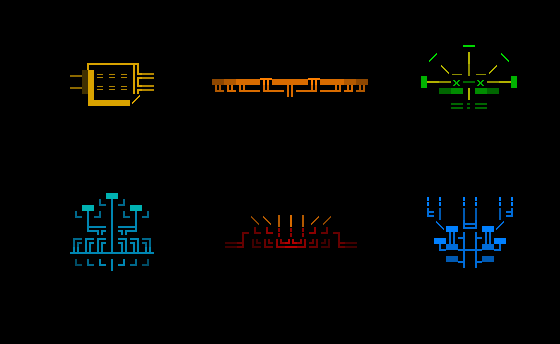
Heat Shielding, Advanced Thermal Shield, Force Field (top row); Improved Remote Shield Generator, Anti-missile System, Improved Energy Mantle (bottom row)
Offense: Enhance offensive capabilities of some weapons, or mitigate negative side-effects of their use.
Resource: Enable Cogmind to manipulate or alter the behavior of mass, matter, energy, heat, salvage etc.
Sensors: Devices for detection and analysis of the surrounding environment.
Stealth: Prevent enemies from tracking and swarming Cogmind, or evade attack more easily.
Storage: Hold parts and resources.
System: Help deal with system corruption, memory issues, and a range of malfunctions.
(The above groups were subdivided for art categorization purpose--as classified in game utilities fall under only six designations: Devices, Storage, Processors, Hackware, Armor, and [REDACTED]. The last category you can discover later in the game.)
Propulsion
Flight: Don’t support much weight, but definitely the quickest way to get around, and even fly over enemies.
Hover: A fairly fast form of movement that can still support a good amount of weight (the viability of both hover and flight have been improved significantly over the 7DRL version).
Wheels: Easy to find, but hard to keep--most wheels are not made for combat.
Legs: A good mix of weight support and speed. And yes, you can hop on one leg ;)
Treads: Slow and heavy duty, for the tank that needs to carry everything and the sun. (No really, you can carry a miniature sun if you need the power.)
Power
An essential but not so varied category in terms of game mechanics. By functionality, the main subdivision for power sources would be “standard” vs “light/micro” versions, where the latter weigh less but in turn come with little capacity for energy storage. But this division is not reflected in the classification system, which is instead based on power level:
Engines (1-3)
Cores (4-6)
Reactors (7-9)
Machines
In this case the art is the on-map image itself, made possible because machines are multi-space props, something you don’t see too often in ASCII roguelikes.
Interactive Machines
The five types of interactive machines have each been covered before--this post contains links to pages describing their functions (along with art, though some has changed since then). Below you can see some variations of Terminals (T), Fabricators (F), Scanalyzers (S), Repair Stations (R), and Recycling Units (Y).
Non-Interactive Machines
This category of machines is mostly for atmosphere, though some may explode if not treated nicely. There are over 100 non-interactive machines which appear in areas that make sense for their intended function.
See more non-interactive machines in their native habitat here (guaranteed lots of destruction and explosions :D).
Animation
It’s really fun to combine static art with the scripting engine to animate it. The engine can import ASCII art files and move glyphs, manipulate colors, handle image layers separately, reference specific art coordinates…
Items
All the item art appears in the data screen for their respective item. Opening info about an item displays its image at the top of the window, animating its appearance:
Title Screen
The game already features some full-sized screens of procedural ASCII, though the title screen is the first of them to combine static art with animation:
Read here for more about how the title screen was put together.
More such animations will be added later for components like the evolution, game end, and game over screens.
UI
I also consider the UI to be art, though more so when in motion.
Even more animated interface elements can be seen in earlier posts about UI feedback and information warfare.
Particle Effects
ASCII particle effects are similarly a form of art, and come in various styles unique to Cogmind. The primary difference being that none of their components are manually drawn--they’re created purely by procedural scripts. Many of these have been shown before in dedicated posts here and here, and their making was discussed here.
Doesn’t hurt to show some more :D
Creating ASCII Art
All of the art in Cogmind was created using an in-house tool: REXPaint. I’ve made it freely available for anyone to use, so check it out! In a future post I’ll be See this post for a guide covering REXPaint’s many potential uses in roguelike development (mockups, art, prefabs, etc.).
If you’re interested in the process used to create some of the game’s art, specifically the item art, I’ve written about it in detail here.












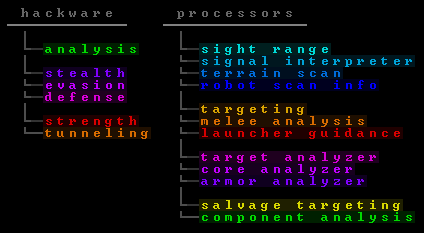


















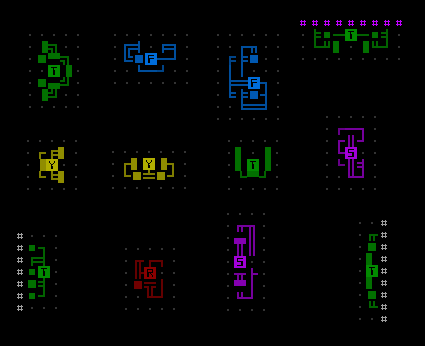
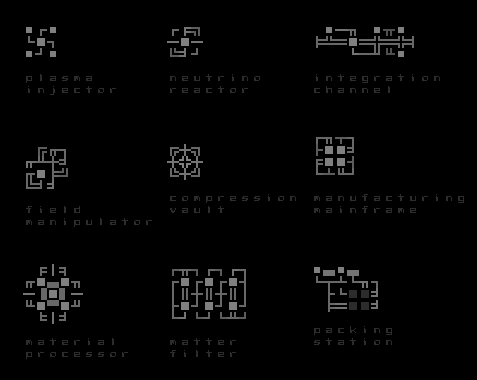
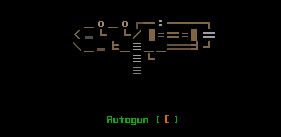
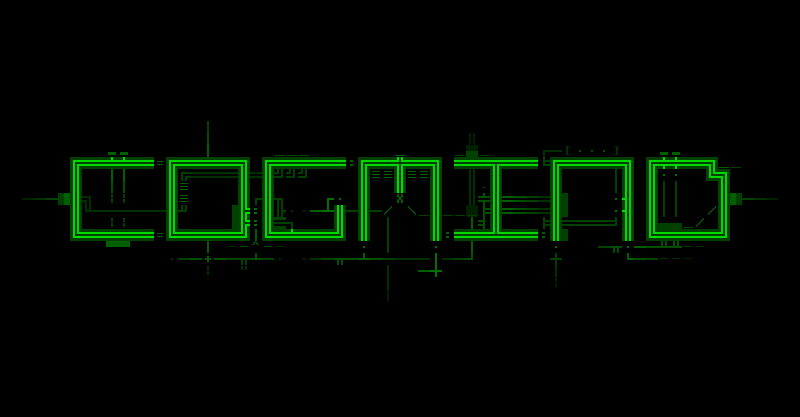
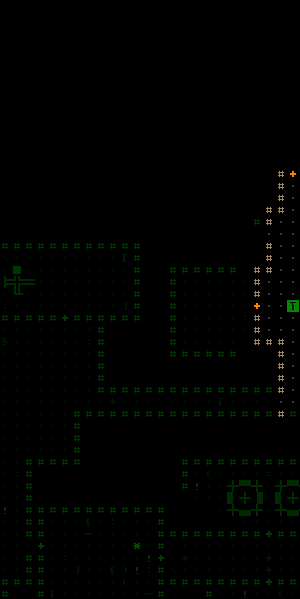
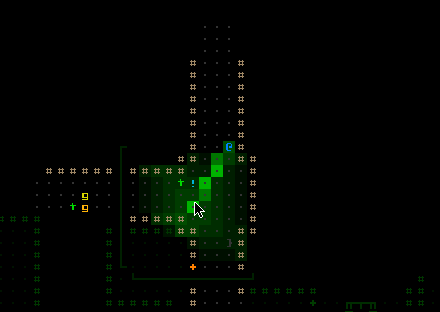
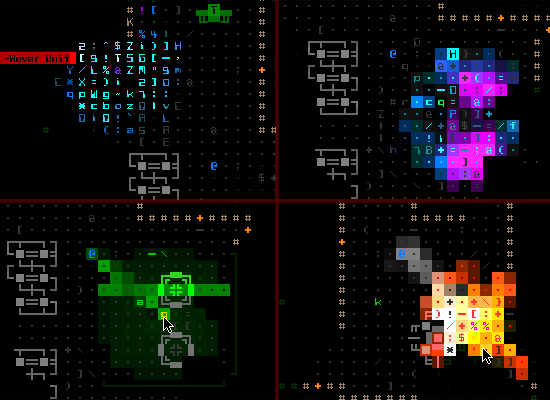



10 Comments
Oh my god I just can’t wait anymore… Is the game going to be paid or free? And do you guys know any game that is similar to Cogmind? I just want to play it like… Right now you know?
Thanks for developing such a masterpiece people, seriously, this game needs to be paid, you really deserve the money :)
The only reason the game is this good is because we’ll be charging for it, yeah ;). It would not be nearly this far along or have as much polish if it were a free game! And good news: If Cogmind recoups development costs, we’ll be following up with more games in the future!!!
Games similar to Cogmind? Not really, at least not in its entirety. Cogmind is quite unique, even within the genre. That said, I can make a few recommendations, or at least point out some other games that reflect various aspects of Cogmind:
In terms of core gameplay similarity there’s The Ground Gives Way, a no-grinding purely item-based approach to roguelikes (but it’s fantasy).
In terms of visuals there’s the popular Brogue (also fantasy). I actually tried this one out only recently, and honestly I think the colorful style somewhat interferes with tactical decision-making, but it’s commonly cited as a good-looking roguelike (as well as being fun to play; and note that its design also de-emphasizes grinding). One major difference you’ll notice in Cogmind is that when nothing is happening there’s lots of black on the map and nothing is moving/animated--this is a conscious decision to make important details more clearly visible for more effective decision-making.
Then there’s Ultima Ratio Regum, which shares almost nothing in common with Cogmind except 1) nice ASCII and 2) it’s one of the only other new/different epic ASCII roguelikes currently in development. Funny that despite being otherwise very dissimilar, URR and Cogmind are often mentioned together these days.
TGGW and Brogue are both already complete and playable. URR is still in early/mid-development, and while it can be downloaded and played, at present there’s no gameplay other than exploration of its highly-detailed open world.
And you’re welcome! We’re happy that you’re looking forward to the game!
Excelent, know about all those games, but still, great recommendations :)
It’s good to see good developers answering every single fan question with such attention and detail. Do you know how much it will cost, btw? Would pay more than 20 for it <3
Good interaction with players is very important in the indie community. We’re not some big faceless corporation here ;)
If you know about all those games then there’s little else I can recommend--only so many roguelike devs out there working on amazing “next-gen” ASCII projects! Of course, I assumed you knew but perhaps you aren’t aware of the downloadable Cogmind prototype? It’s not really much compared to what the game’s become, but still fun in its own right. (Playing it now could spoil a few things, though not much since a lot has changed.)
As for pricing, I wouldn’t make you pay more than $20 =p. Actually, I think we’ll get the most sales around the $10~15 area, so the base price is likely to be $15. I would love to give strong supporters the opportunity to invest more in Grid Sage Games to make this and other future games possible, though I suppose you can always buy multiple copies, too! But that’s one reason I’m still considering a KS campaign, just as a way to let those of you willing to help out more do that for a few extra perks. Really need to decide on that…
Huh… Kickstarter sounds good, and since you are going serious and you aren’t one of those devs that say “we didn’t complet kickstarter, no game for u fuck you all we keeping da money though bye” because… You know, you are like 50/60% done with the game.
Know what? Kickstarter sounds awesome and I am sure that its going to be a sucess, you should try it, maybe it can speed up the development a bit :)
We’re more like 70% done by my estimates (which I hope are more accurate than yours =p). And there is zero chance of non-delivery, yes (unless I die, which I’d like to think will not happen anytime soon…).
It would actually slow down development, because running a campaign takes a lot of extra effort, and it wouldn’t be providing funding for full-time development since I’m already doing that… The purpose would be marketing/exposure and pulling in “extra” funding through perks. I’m pretty sure it would be successful, too, with a reasonable goal anyway, where the funds are put towards developing unfinished outsourcable parts of the game like more audio and art.
I’ve mulled the KS possibility in public before, by the way (see here).
Will you try to go through STEAM Greenlight?
Yep, will be on Greenlight next year. Just waiting until we at least have one good trailer.
Absolutely mind-blown.
Keep up the great work! What a great looking game :)
“Grid Sage Games: Blowing minds one at a time until there are none left to play the game when it releases” ;)
Seriously, thanks, and stick around for more mind-blowing ASCII goodness! (Though it’ll be difficult to top this post in the near term because it’s got so much damn stuff in it =p. Still, other interesting posts coming soon…)